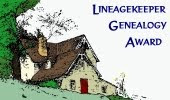Ten years ago, I started using the Internet for web meetings with my far flung U.S. and international cousins. These cousins groups enjoy a synergy of skills, resources and opportunities that exceeds the sum of the abilities of those involved. My cousins and I have jointly produced amazing results on research 'problems' that had stymied other family history researchers for centuries. The key word here is 'Team'.
If each member of these research teams actively engages in research and openly shares findings and participates in research discussions, amazing progress and discoveries result. The math a little different than we learned in grade school because in these teams one plus one equals two'ish and four plus four equals ten or twelve'ish. There is a great multiplying factor when the various members apply their unique perspectives in solving the problem(s) at hand.
Tonight I participated in a live webcast via UStream and a chat client. UStream resides on the wild, wild, web, but you don't need to delve in to the oddities created by others. You can create your own shows on UStream for free! Just create an account and then
 create your own show(s). Then tell your guests the web address and the time to join the show. You control the content, so the program will be as good as you make it.
create your own show(s). Then tell your guests the web address and the time to join the show. You control the content, so the program will be as good as you make it.The presenters tonight broadcast live video from their home den teaching the attendees how to maximize the technology that is so readily available. This technology has a surprisingly low threshold of learning. Its use can significantly increase your effectiveness in family history research by engaging far flung members of research teams. How far is far flung? They may be on the other side of the earth or two doors away, but if they aren't sitting by you, they are 'far flung'. Electricity travels at the speed of light and even though traffic on the Internet isn't quite that fast, it 'almost' is, so distance isn't much of a factor any longer.
Ok, that all sounds great, but what equipment do I need if I want to host a broadcast or similar meeting session? All you need is a fast (broadband) internet connection, a webcam and a good microphone, plus the ability to talk intelligently, while reading the chat postings and keeping everyone focused on the subject, goal or task at hand.
Anyone can be the host of a webcast like those that I've participated in today. Anyone can be successful at it with a little planning and practice. You'd be surprised how quickly folks learn to use and engage in these forums.
There are hundreds of broadcast tools available. I found an open source product (meaning free to use) called DimDim and installed it on a server at work. It is great! I can send video of me, along with my voice and real time views of my computer desktop, applications I'm running, Powerpoint presentations, etc., to folks around the world and never have to get up from my desk. When one of my business contacts needs to see how to use some of the software tools we supply, I can show them step-by-step instructions using the tools doing real work in real time! All they need on their end is a broadband connection, a computer and a web browser like Firefox, Opera, etc. (Internet Explorer will work, but I don't like it).
DimDim would serve equally well among family history research groups. Go to the home page and watch the demos.
Don't think you want to install software on a server but want to use a webcast to teach your family history class or host a family history webcast? Drop a note to the great folks at familyhistoryonline.com and ask them if they will let you use their system and tools. You may be surprised at the response! Download the free ReGL viewer / control and ask Gena and Tex for some tips and pointers and you'll be ready to go. (P.S. They are particularly fond of family history library support staffs).
So why all this tech talk in a family history note? Am I a geek? Sure I am and so are a lot, if not most of you. If you aren't now, you soon will be when you tumble to the perspective of how much technology enhances your ability to do family history research, both alone and in teams of others. The tools are here. The cost is little to nothing. Don't say you can't learn to use them, because 'that dog don't hunt' argument doesn't cut it any more. Anyone can learn to use the great online social interaction tools that exist now. Keep your eye on the ball and out of the gutter when looking for solutions on line and you'll be amazed at what you find.
Call, write or e-mail your cousins or fellow researchers today and get the group involved in your (their) own webcast. Better yet, call them live using your (their) Skype software and set the agenda, time and date as soon as you finish reading this note. Try it, you'll like it.









0 comments:
Post a Comment